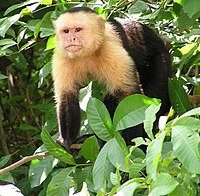
Photo from wikipedia
The critically endangered white-headed langur (Trachypithecus leucocephalus) is confined to fragmented karst forests of southwest Guangxi Province, China. A lack of information on the influence of habitat fragmentation on langur… Click to show full abstract
The critically endangered white-headed langur (Trachypithecus leucocephalus) is confined to fragmented karst forests of southwest Guangxi Province, China. A lack of information on the influence of habitat fragmentation on langur behavior has prevented a comprehensive understanding of their ranging behavior and the development of effective langur conservation strategies. We collected comparative data on time budgets, daily path lengths, home range and diets of four langur groups inhabiting the lightly fragmented Fusui forest (G1, G2) and the more heavily fragmented Chongzuo forest (G3, G4). The aim was to explore the effect of this fragmentation on langur ranging behavior. Our results showed that the Fusui groups spent more time on moving and less time on feeding and playing than the Chongzuo groups. Daily path lengths were 472.4–536.1 m for the Fusui groups and 449.6–480.7 m for the Chongzuo groups, indicating no marked inter-site variation. The Fusui groups occupied much larger home ranges (23.8–33.8 ha) than the Chongzuo groups (14.5–15.8 ha). However, all groups had similar monthly home ranges. Diets significantly differed among langur groups. The Fusui groups consumed more young leaves and had much lower diet diversity compared with the Chongzuo groups. Our findings indicate that habitat fragmentation is one of the crucial determinants of white-headed langur ranging behavior because fragmentation reduces and restricts the home range. Langurs in fragmented habitat adopt an energy conservation strategy characterized by devoting more time to feeding and less time to moving, with a smaller home range and consumption of more plant species. We argue that linking fragmented forests with corridors should be considered a priority in a wider and comprehensive longer term langur population conservation and habitat management strategy.
Journal Title: Primates
Year Published: 2017
Link to full text (if available)
Share on Social Media: Sign Up to like & get
recommendations!